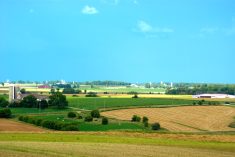Conestoga Meats in Beslau, Ont., a producer-owned pork processing co-operative, has grown its exports to where it now exports about half of its production, most of it to Asia.
Conestoga is in the middle of a $50 million expansion, made possible by the success of its quality pork and strong producer-ownership story.
The company is an example of the success that’s possible in exports for Canadian companies, as the agriculture sector is challenged to increase its exports by another 27 per cent by 2025.
Conestoga isn’t alone. The Ontario Corn Fed Beef program increased its exports to Japan by 51 per cent in 2017 over 2016 and built sales of 1.5 million pounds of beef in China from almost nothing.
Read Also

Ontario’s agri-food sector sets sights on future with Agri-Food 2050 initiative
The first-ever Agri Food 2050, a one-day industry event dedicated to envisioning the future of food and farming in Ontario,…
In Manitoba, Hylife is growing, recently opening a $176 million expansion of its pork processing plant at Neepawa, driven by markets in Asia.
These three organizations are already a growing part of the opportunity that the Canadian government, farm groups and agriculture economists see for Canadian food in the rest of the world.
The question is where to focus energies to achieve export goals.
In the report by the Canadian Agri-Food Policy Institute (CAPI), there were opportunities outlined that serve as a roadmap for aggressive Canadian agriculture and food companies looking to increase their influence outside of the country.
The opportunities aren’t just because of market access through trade deals like the Comprehensive Economic and Trade Agreement (CETA) with Europe and the Comprehensive and Progressive Agreement for Trans-Pacific Partnership (CPTPP), they are underpinned by distinct advantages that together mean greater chances for success for Canadians looking to grow the agriculture and food sector.
The CAPI report showed that its focus groups agreed with the opportunities mentioned in the Barton report.
A lot of Canadian agriculture’s assets become advantages because they are backed by reputation. Canada is already known in the world for particular attributes, we don’t have to prove them.
The CAPI report identified some areas where Canada has the reputation to build growth. They include:
- Being known for safe food grown in a clean environment.
- A producer of high quality food.
- A reputation for and a track record on environmental responsibility.
Arnold Drung, president of Conestoga Meats, said the Canadian reputation for quality product underpins the ability to export.
“Overall the quality of the Canadian product is good and is recognized as such internationally,” he said. Canada’s strong food regulatory regime also helps underpin the reputation for quality, he said.
However, the hog sector has been aggressively exporting for 25 years and that has meant an established system of trading, with international traders with good contacts in foreign markets. Some sectors might take time to develop those ties.
Conestoga Meats is currently undergoing a major construction project, replacing aging infrastructure and building new potential for growth. Whether that growth is chased will be determined by the extent of the current global instability in trading, said Drung.
He recommends that companies interested in exporting look at the government programs available to help. The trade commissioner service has a lot of information. The CAPI report mentioned Canada’s strong global market intelligence as providing opportunities.
“It’s important to go in with eyes wide open,” said Drung. “Different markets have different challenges. It’s not a level playing field in all markets.”
The Ontario Corn Fed Beef program has been in Asian markets a shorter time – four years in Japan, but those exports help to improve carcass value, said John Baker, director of business development and brand management with the Ontario Corn Fed Beef program (OCFB). The OCFB program is run by the Ontario Cattle Feeders Association.
“We are postitioned as a premium Canadian beef brand. We focus a lot on production aspects in the Japanese market, and the credibility of that our quality assurance program provides carries significant value,” he said.
Building relationships with their foreign buyers has been key to their success, along with having the differentiated, quality assured product story to tell. Strong partnerships with processors in Canada, such as Cargill Meats and St. Helen’s Meat Packers have also been important to buyers, said Baker.
They have also made strong use of the provincial and federal trade commissioners.
Capitalizing on demographics
Other opportunities outlined are around demographic changes in the world on which Canada can capitalize. They include growing affluent populations, especially in Asia, interested in high value proteins. Canadian meat marketers are at the forefront of this trend in the agriculture sector. But there are also opportunities in novel plant proteins, something recognized by the selection of the Protein Industries Supercluster as one of five innovation superclusters funded by the federal government.
Canadian trade agreements with Europe (called CETA) and the signed, but not-yet-implemented CPTPP are important because they open up easier access to opportunities.
There’s also potential opportunity because of changing policy and markets within Canada.
The National Food Policy process brought together groups involved in farming and food who have not always talked, including representatives from almost everybody in the process from farmers to food security activists. The process also forced government ministries to talk to each other about food, something they have not done well in the past.
That increase in dialogue could lead to new opportunities and local markets, or efficiencies that have not been previously contemplated.
The desire of many Canadians to buy local, differentiated food is also an opportunity, especially when sales of such food could reduce imports.
Then there are the natural capital assets that Canada possesses in abundance, compared to the rest of the world, including clean soil and air, diverse growing regions and seasons, which could create opportunities, the report said.
Canada also possesses the agriculture and food science infrastructure to create new tools and value-added products for global markets. There are opportunities in creating and using new advanced tools for food production.
Opportunities require someone to seize them, but in the agriculture sector, there are plenty of positives aligning to help drive an increase in business, both domestically and in exports.














